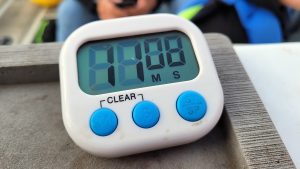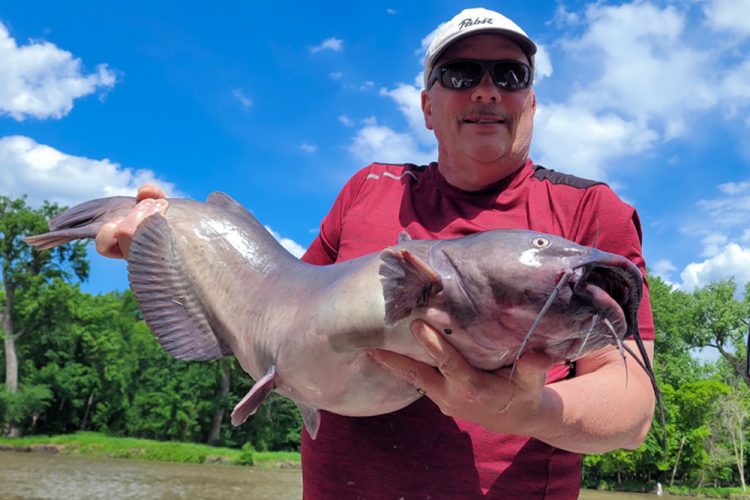Long-time guide customer Rod showed up for his annual trip in 2024 to find
fast-dropping water after a high-water event. The fish were where they were
supposed to be, but the timer told Rod and his guide, Brad Durick, that they
had to sit on them at least one hour before they would take the bait.
Timer Time
by Brad Durick
Running a timer is such a simple thing to do, but many if not all catfish anglers I know still don’t use a timer when fishing. Last summer, I thought a lot about the timer and how such an inexpensive little tool helps me catch many fish and learn a lot about them.
For the timer to truly work, however, you should be on some sort of pattern where fish are biting. It can also be used to help you establish a pattern.
20 Minutes
Twenty minutes is always the baseline for catfishing. Going back over two decades, that is what I have always heard and personally used.

As soon as I get my lines set, the first thing I do is grab my trusty kitchen timer and set it to 20 minutes. If I get a fish, I mark the time and let the timer run. If there is not a second fish, I will usually hit reset and give the spot five to 10 more minutes just to see if there is any action.
When I move, I start the procedure over again, taking note of a fish or not. By the third spot, you should know if the fish are biting aggressively or biting slower. From there, you know if you can get away with fast moves or if you have to sit on the fish a little longer.
When to Sit for Less Time
Sometimes the stars align and the catfish are snapping. If you set a timer at each spot, you will quickly realize that if there are active fish they will bite fairly quick. If you mark the second fish and so on, you can determine that the fish are active. If you get a couple fish then nothing by the second or third spot, you will know to move on after two or three fish caught. Now you are getting to a fresh spot rather than hoping or waiting for that next fish to bite.
This is where many anglers, if they have quick success on a spot, think it is a hotspot and will way over sit the spot rather than moving onto the next spot to get the active fish. If this pattern sets up, being willing to move rather than sit can make a good day a great day in a hurry.
Here’s my favorite story to go with this discovery. I was on a great spring bite and figured out that the first fish on a spot was hitting within five minutes. If there was a second, it would be on by minute eight and if a third by minute 17. That day we were moving right at the 20-minute mark, and we put together a 30-plus catfish day which is stellar.
Later that summer, I ran into a guy who was on the river the same week as that bite. He started asking how I was catching 30 fish when he was only catching 10. I told him how I derived the pattern with the timer and noted that we would get one or two then sit for 20-30 minutes more waiting for the next fish. We were able to figure out that I was fishing three spots per hour and he was fishing one because he kept waiting for the next fish before finally giving up and moving on. This was not wrong. It was natural just not as efficient.
When to Sit Longer
Sometimes it just takes longer to get the fish to find and take the bait. This generally occurs after something environmental like a cold front, a fast rise or fall in the river level or even a sunny versus cloudy day.

Start with the baseline of 20 minutes, but if there are no bites, just give the spot a little more time—up to 30 or 35 minutes. Sometimes you will notice that you sit there for that first 20 minutes with nothing, then a little later you get a fish.
I know I have moved too quick and left fish behind. One great story about this involved a return couple I was guiding. We were struggling to get bites. On the third spot, we ended up in fairly deep conversation, and the 20-minute timer went off. I hit reset and ignored it until I noticed we were 15 minutes into the second timed period. Thinking we were now wasting time, I told the couple we needed to leave and, just like that, we caught three fish. At the next spot, 20 minutes went by, I hit reset and right at the 35-minute point, we caught two more fish. We did this for the rest of the trip but setting a 30-minute timer at the beginning. We put together a great day by waiting.
Where Can You Get a Timer?
Timers are with most of us all the time. Just about everyone carries a smartphone with a built-in timer. Just set it and wait for it to go off.
Another that I use frequently is the timer or clock on my depthfinder. This is a simple way to keep track of time right on the dash of the boat.
My favorite, and the one that I use most often, is a simple $2 to $3 kitchen timer I bought online. I can set it and go from there. Most run on one AAA battery and are very easy to use. I also like that when a fish is caught, they are right there to mark the time. These timers are inexpensive enough that I usually buy a couple at a time. If I get a season or two out of one timer, I am happy.
When those fishing with me see the system work, it makes sense. I call running a timer my second-best technology for catching fish right after my river map. It can help you pattern your spots to be more efficient.
(Captain Brad Durick is a nationally recognized catfish guide on the Red River of the North, seminar speaker, and author of the books Cracking the Channel Catfish Code and Advanced Catfishing Made Easy. For more information go to redrivercatfish.com.)



